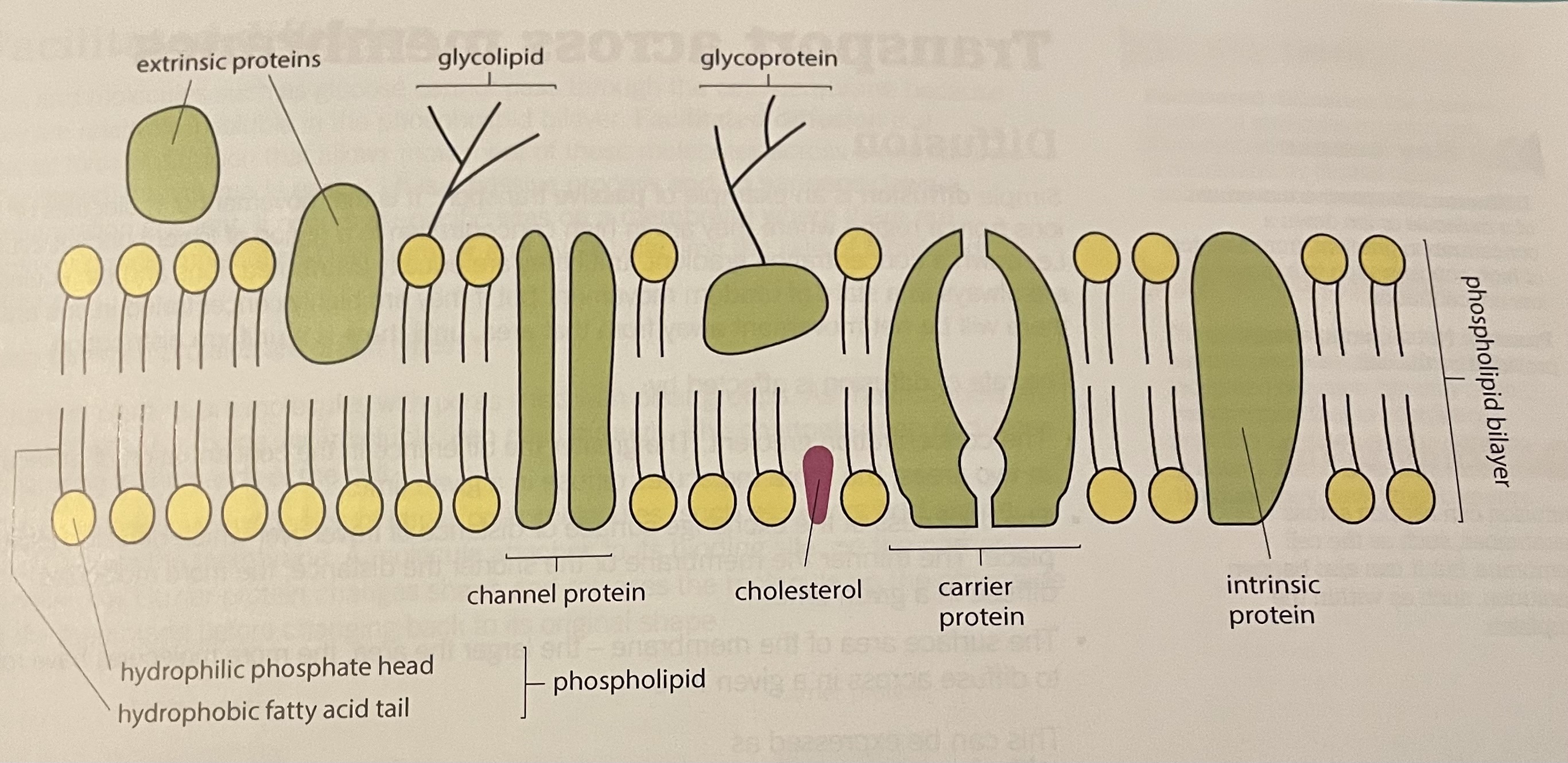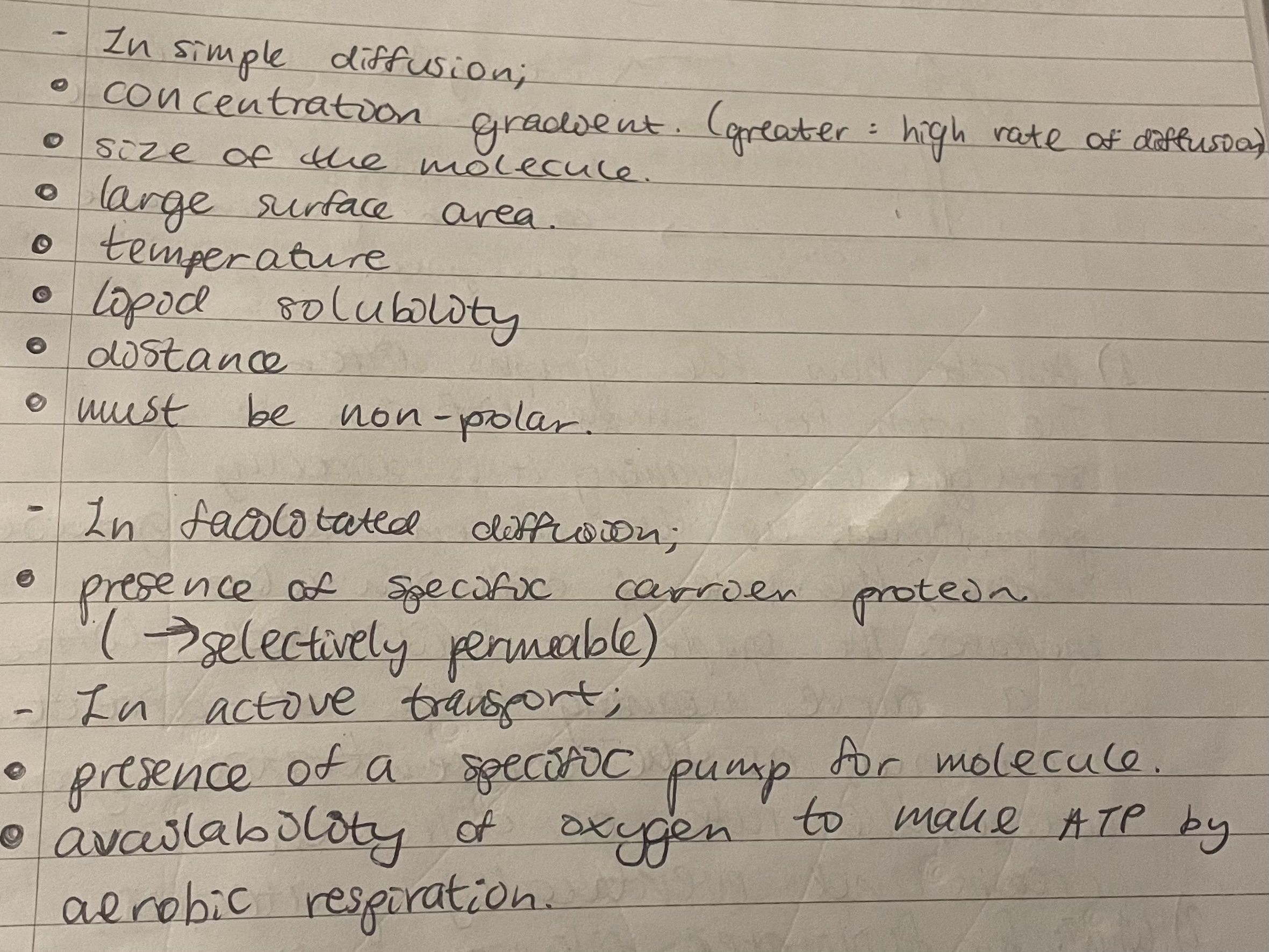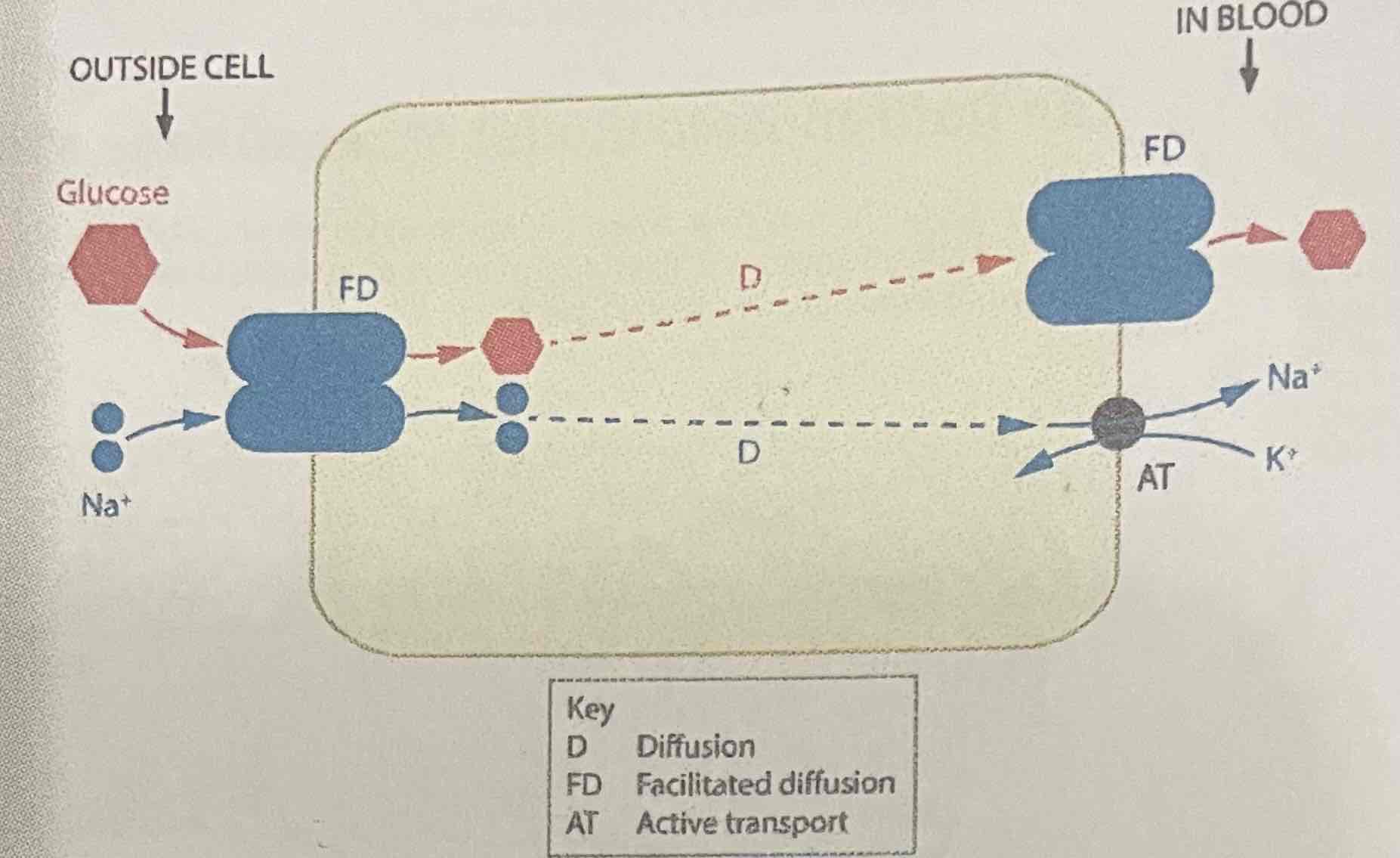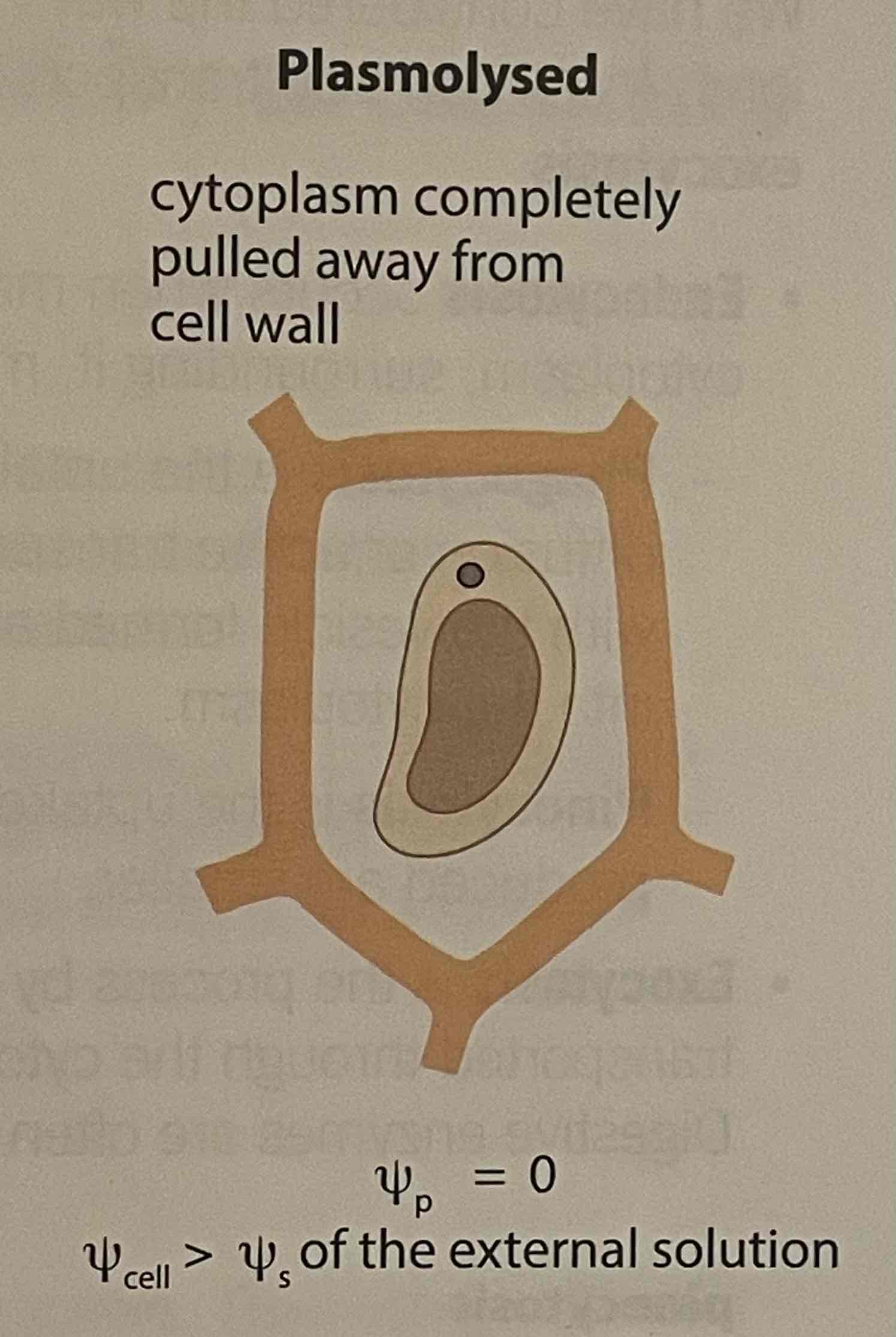WJEC AS Biology Unit 1.3 - Cell membranes and cell transport
1/92
There's no tags or description
Looks like no tags are added yet.
Name | Mastery | Learn | Test | Matching | Spaced |
|---|
No study sessions yet.
93 Terms
Principal components of the plasma membrane
Phospholipid bilayer
Extrinsic and intrinsic proteins
Cholesterol
Glycoproteins and glycolipids
Plasma membrane structure (diagram)

Plasma membrane structure (description)
Phospholipids form a phospholipid bilayer;
hydrophobic fatty acid tails point towards each other and meet in the middle
hydrophilic heads are on the outside, interacting with water inside or outside the cell
Cholesterol is found between the fatty acid tails and helps maintain the stability of the membrane
Intrinsic proteins span both layers of the phospholipid bilayer (carrier proteins/channel proteins)
Extrinsic proteins are associated with one of the layers of the phospholipid bilayer
The proteins may be attached to carbohydrates —> a glycoprotein. These form the glycolax and play an important role in cell recognition and signalling
Fluid mosaic model
Model of the structure of biological membranes, in which proteins are studded through a phospholipid bilayer, as in a mosaic. The movement of molecules within a layer of the bilayer is its fluidity.
Mosaic; embedded proteins. These proteins produce a pattern
Fluid; the individual phospholipids can move within each phospholipid layer relative to each other
Phospholipids in the cell membrane
important components of cell-surface membranes and form the basis of membrane structure because;
can form bilayer, with one sheet of pl molecules opposite another
inner layer of pls has its hydrophilic heads pointing in, towards the cell, and interacts with the water in the cytoplasm
outer layer of pls has its hydrophilic hydrophilic heads pointing outwards, interacting with the water surrounding the cell
hydrophobic tails of the two pl layers point towards each other, to the centre of the membrane
the pl component of a membrane allows lipid-soluble molecules across, but not water-soluble molecules
Proteins in the cell membrane
scattered through the phospholipid bilayer of the membrane
Two ways in which they’re embedded; extrinsic proteins or intrinsic proteins
Move freely within the pl bilayer. The ease with which they move is dependent on the number of pls with unsaturated fatty acids in the pls
Types;
enzyme or signalling protein
carbohydrate chain + glycoprotein —> glycolax; for cell recognition so cells group together to form tissues
Extrinsic protein
Intrinsic protein; carrier protein/pump or channel protein/hydrophilic channel
Receptor; for recognition by hormones
Extrinsic proteins
on either surface of the bilayer
Provide structural support
Form recognition sites, by identifying cells
Form receptor sites for hormone attachment
Intrinsic proteins
extend across both layers of pl bilayer
Include transport proteins, which use active or passive transport to move molecules and ions across the cell membrane
Glycolipids
lipids with carbohydrate chains attached
Occur in both plant and animal membranes
Glycoproteins
Function as the receptors for chemical signalling
+ carbohydrate —> glycolax
Exist in both plant and animal cell membranes
Channel proteins
mechanism of facilitated diffusion
Intrinsic proteins
Carrier protein
mechanism of facilitated diffusion
Intrinsic proteins
Cholesterol in the membrane
exists only in animal cells
Occurs between the fatty acid tails of the pls
Make the membranes more stable at high temps and more fluid at low temps
Glycolax
carbohydrate + glycoprotein —> glycolax
Play an important role in cell recognition and signalling
Some have roles as hormone receptors, in cell-to-cell recognition and in cell-to-cell adhesion
Hydrophobic areas of the membrane
fatty acid tails
Face inwards
Hydrophilic areas of the membrane
phosphate heads
Face outwards into aqueous solution
Properties of cell membranes
only small lipid-soluble molecules are able to diffuse across the phospholipid bilayer
Water soluble molecules are unable to diffuse across due to the hydrophobic properties of the fatty acid tails
Selectively permeable - depends on the carrier proteins present
Fluidity of carrier proteins present means that membranes are able to fuse, allowing endocytosis or exocytosis
The presence of unsaturated fatty acids or the length of fatty acid chains also affects the ability and fluidity of membranes
Functions of cell membranes
plb is a physical barrier to polar, charged and large molcules
Compartmentalisation; higher concs of reactants and enzymes
exocytosis; allows the release of substances from cells
endocytosis; allows materials to be taken in to cells
location of receptors for hormones
Glycoproteins have a role in cell recognition
How structure and properties allow functions of cell membranes
The plb is impermeable to charged molecules and polar substances
It acts as a physical barrier to cell and membrane-bound organelles
the presence of specific carrier proteins/pumps make it also selectively permeable to different substances
Individual components are able to move around, membranes are able to fuse, allowing endocytosis
Specific proteins in the membranes act as binding sites for hormones (receptors)
Glycolax plays a role in cell recognition
Permeability of the cell membrane
small molecules, e.g oxygen and carbon dioxide, move between phospholipid molecules and diffuse across the membrane
Lipid-soluble substances, e.g. vitamin A, dissolve in phospholipid and diffuse across the membrane. The pll is hydrophobic so l-s molecules move through the cell membrane more easily that w-s substances
W-s substancece (e.g. glucose, polar molecules and ions) cannot readily diffuse through the phospholipids and must pass through intrinsic protein molecules, which form water-filled channels across the membrane. As a result, the cell-surface membrane is selectively permeable to water and some solutes

Factors affecting permeability of the cell membrane
temperature
Organic solvents
In active transport;
presence of a specific pump for molecule
availability of oxygen to make ATP by aerobic respiration
In facilitated diffusion;
presence of specific carrier proteins (—> selectively permeable)
In simple diffusion;
conc gradient (greater = higher r. Of diff)
Size of molecules
Large surface area
Temperature
Lipid solubility
Distance
Must be non-polar
Draw a fluid mosaic model

Diffusion
The passive movement of a molecule or ion down a conc gradient from a region of high concentration to a region of low concentration
Rate of diffusion
(surface area x concentration gradient)/diffusion distance or length of diffusion path
Factors affecting the rate of diffusion

Facilitated diffusion
The passive movement of molecules or ions down a conc gradient, across a membrane, by protein carrier molecules in the membrane
Factors affecting rate of facilitated diffusion
presence of specific carrier proteins (—> selectively permeable)
Types of facilitated diffusion
Channel proteins (ions)
Carrier proteins (larger polar molecules)
Facilitated diffusion with channel proteins
Ions (charged and hydrophilic molecules)
Move through channel proteins in the membrane
Lined with hydrophilic groups/water
Passive process
Ions move from a higher concentration—>a lower concentration the other side of the membrane
Channels of the protein may open under certain conditions (gated)
Facilitated diffusion with carrier proteins
Larger polar molecules such as amino acids and sugars
Carrier proteins interact with the molecule to be transported, causing the carriers to change shape
Examples of carriers include glucose permease and amino acid transporters
Carriers=specific to the molecule they transport
Different transporters for different molecules therefore membranes=selective
For it to be facilitated, the molecules must move from a higher conc—>a lower conc
Passive process, no energy required
Active transport
The movement of molecules or ions across a membrane against a concentration gradient, using energy from the hydrolysis of ATP made by the cell in respiration
Ions and molecules are moved from a lower to a higher concentration against the concentration gradient
Required energy from ATP
Occurs through intrinsic carrier proteins spanning the membrane
Rate is limited by the number and availability of carrier proteins
Factors affecting transport across cell membranes overall
Conc gradient
Size of molecule
Large surface area
Temperature
Lipid solubility
Distance
Must be non-polar
Active transport and respiration
At higher conc differences across a membranes rate of uptake increases and reaches a plateau, at which the carrier proteins are saturated
The rate of uptake is reduced with the addition of a respiratory inhibitor
Active transport and cyanide
cyanide = respiratory inhibitor
Prevents aerobic respiration + the production of ATP in the mitochondria
Without ATP, active transport cannot occur
Cyanide reduces active transport
Co-transport
A transport mechanism in which facilitated diffusion brings molecules and ions, such as glucose and sodium ions, across the cell membrane together into a cell
Type of facilitated diffusion that brings molecules into cells together on the same transport protein molecule
Sodium-glucose co-transport is significant in absorbing glucose and sodium ions across cell membranes and into the blood in the ileum and the kidney nephron
Process of co-transport
A glucose molecule and two sodium ions outside the cell attach to a carrier proteins spanning in the cell membrane
The carrier protein changes shape and deposits the glucose molecule and the sodium ions inside the cell
The glucose molecule and sodium ions separately diffuse through the cell to the opposite membrane
The glucose passes into the blood by facilitated diffusion and sodium ions are carried by active transport

Osmosis
The net passive movement of water molecules from a region of higher water potential to a region of lower water potential through a selectively permeable membrane
Water potential
The tendency for water to move into a system
Water moves from a solution with higher water potential (less negative) to one with a lower water potential (more negative)
Decreased by the addition of a solute
Pure water = 0
Solute potential
A measure of the osmotic strength of a solution. Reduction in water potential due to presence of solute molecules
Tendency of water to leave due to conc of dissolved solutes in cytoplasm
Negative value
Pressure potential in osmosis in plant cells
the pressure exerted by the cell contents on the cell wall
Generates a force, pushing water out of the cell
Positive value
Makes the cell turgid
The water potential equation
Water potential = pressure potential + solute potential
Pressure potential = water potential - solute potential
Solute potential = water potential - pressure potential
Plasmolysis
The retraction of the cytoplasm and the cell membrane from the cell wall as a cell loses water by osmosis
Hypotonic solution
The surrounding solution has a lower conc of dissolved solutes and therefore a higher water potential than the cell
Hypertonic solution
The surrounding solution has a higher conc of dissolved solutes and therefore a lower water potential than the cell
Isotonic solution
The surrounding solution has the same water potential as the cell
Incipient plasmolysis
Where the cell membrane and cytoplasm are partially detached from the cell wall due to insufficient water to make cell turgid
Turgor and plasmolysis in plant cell osmosis
Turgid;
cytoplasm pushed against cell wall
Water potential = 0
Pressure potential =-solute potential
Incipient plasmolysis;
cytoplasm beginning to pull away from cell wall
pressure potential = 0
water potential of cell = solute potential
Plasmolysed;
cytoplasm completely pulled away from cell wall
Pressure potential = 0
Water potential of cell > solute potential of the external solution
Osmosis in animal cells
No cell wall and so pressure potential does not have to be considered
Water potential therefore = solute potential
May cause osmotic lysis or haemolysis
Haemolysis; without a cell wall, as water enters a red blood cell, the cell bursts
Bulk transport
A cell can transport materials in bulk into and out of the cell
Exocytosis and endocytosis provide a mechanism for bulk transport across a cell membrane and these processes change the surface area of cells as they occur
Endocytosis
The active process of the cell membrane engulfing material, bringing it into the cell in a vesicle
Occurs when material is engulfed by extensions of the cell membrane and cytoplasm, surrounding it, making a vesicle Occurs
Two types;
phagocytosis
pinocytosis
Exocytosis
The active process of a vesicle fusing with the cell membrane, releasing the molecules it contains
Digestive enzymes often secreted in this way
Phagocytosis
The active process of the cell membrane engulfing large particles, bringing them in the cell in a vesicle
The products are absorbed into the cytoplasm
Pinocytosis
The active process of the cell membrane engulfing droplets of fluid, bringing them into the cell in a vesicle
Why phospholipids form a bilayer
Hydrophilic and hydrophobic properties
What determines the position of a protein in a membrane
Polarity
Collective name for glycoproteins and glycolipids on the outer surface of the membrane
Glycolax
Feature of the phospholipid bilayer that prevents polar and charged particles from crossing the membrane
the bilayer has a hydrophobic core that prevents the passage of polar molecules while allowing the relatively free diffusion of non-polar molecules
Name two gases that can cross the membrane by simple diffusion
Carbon dioxide
Oxygen
Name two vitamins that can cross the membrane by simple diffusion
Vitamin A
Vitamin K
How lipid solubility affects the rate of diffusion
the molecules which are soluble in lipids can diffuse easily across the cell membrane. Some molecules are hydrophilic and not soluble in lipids. Therefore, they do not diffuse easily across the cell membrane and require the involvement of specialized proteins for their transport
How the size of the molecule affects the rate of diffusion
The rate of diffusion is inversely proportional to the size of the molecules. This means that the smaller is the size of the molecule, the higher is the rate of diffusion
How the surface area of the cell membrane affects the rate of diffusion
As the surface area of the membrane increases, the rate of diffusion also increases, as there is more space for molecules to diffuse across the membrane
Adaptation of the cell membrane that increases surface area
Microvilli
How diffusion path affects the rate of diffusion
The shorter the distance the substances have to move, the faster the rate of diffusion
How concentration gradient affects the rate of diffusion
The greater the concentration gradient, the quicker diffusion takes place
How temperature affects the rate of diffusion
Higher temperatures increase the energy and therefore the movement of the molecules, increasing the rate of diffusion. Lower temperatures decrease the energy of the molecules, thus decreasing the rate of diffusion
State the differences between simple and facilitated diffusion
In simple diffusion, molecules move without the assistance of membrane proteins, whereas in facilitated diffusion, membrane proteins assist molecules in their movement downward
SD = small, non polar molecules, FD = large or polar molecules

State the similarities between simple and facilitated diffusion
Passive processes
Transport molecules or ions
Occurs down a conc gradient
Substances transported by simple diffusion
small non-polar molecules, including oxygen and carbon dioxide
Substances transported by facilitated diffusion (carrier protein)
Larger polar molecules such as amino acids and sugars
Substances transported by osmosis
Water molecules
Substances transported by active transport
Examples of molecules which the cell needs high concentrations of include ions, glucose and amino acids
Substances transported by facilitated diffusion (channel protein)
Ions (charged and hydrophobic molecules)
Examples of co-transport
Sodium-glucose co-transport; significant in absorbing glucose and sodium ions across cell membranes and into the blood in the ileum and the kidney nephron
No net movement of water meaning
Solutions are isotonic to each other
What happens if a red blood cell is placed in an isotonic solution
Isotonic solution has the same concentration of dissolved solutes as rbc
It has the same water potential as RBC
There is no net movement of water into or out of the cell
What happens if a red blood cell is placed in a hypotonic solution
Hypotonic solution has a lower concentration of dissolved solutes than the RBC
It has a higher water potential than inside the RBC
Water mixes from the higher water potential of the surrounding solution into the cell by osmosis
The cell bursts due to osmotic lysis
What happens if a red blood cell is placed in a hypertonic solution
Hypertonic solution has a higher concentration of dissolved solutes than the RBC
It has a lower water potential than the RBC
Water moves from the higher water water potential inside the cell into the external solution by osmosis
The cell loses volume/becomes cremated (shrink + shape changes, usually with a ruffled or scalloped border)
Osmotic lysis
Bursting/rupturing of the cell membrane due to osmotic movement of water into the cell when in a hypotonic environment
Why osmotic lysis doesn’t occur in plant cells
The presence of a cell wall
Equation for water potential in plants
Water potential = pressure potential + solute potential
Pressure potential
The hydrostatic pressure exerted by the cell contents on the cell wall. Equal and opposite to the pressure exerted by the cell wall on the cell contents
Solute potential
Tendency of water to leave due to concentration of dissolved solutes in cytoplasm
Plasmolysed cells

Meaning of active in membrane transport
Requires energy in the form of ATP
Features of active transport across the cell membrane
active process
Molecules move from a lower conc —> a higher conc (against conc gradient)
Requires energy in the form of ATP
Examples include Na+/K+ pumps (Needed for nerve transmission)
Because these cells need to produce a lot of ATP, they need a lot of oxygen to produce ATP in aerobic respiration
Examples of molecules which the cell needs high concentrations of include ions, glucose and amino acids
Process of active transport
Active uptake of a single molecule or ion occurs as follows;
The molecule or ion combines with a specific carrier protein on the outside of the membrane
ATP transfers a phosphate group to the carrier protein on the inside of the membrane
The carrier protein changes shape and carries the moelcule or ion across the membrane, to the inside of the cell
The molcule or ion is released into the cytoplasm
The phsophate ion is released from the carrier molcule back to cytoplasm and recombines with ADP to form ATP
The carrier protein returns to its orginal shape
Why the rate of active transport and facilitated diffusion are limited
number of carrier and channel proteins becomes limited as they are all occupied
Term for release of substances from vesicles by the vesicle membrane fusing with the cell membrane
Exocytosis
Tern that describes a cell engulfing a particle to enclose it in a vesicle with the cell membrane
Endocytosis
Effect of exocytosis on the surface area of a cell membrane
Increases the surface area of a cell membrane by fusing intracellular vesicles to the plasma membrane
Effect of endocytosis on the surface area of a cell membrane
decreases the surface area of a cell membrane
Forming glycolax from the extracellular surfaces of the proteins
The extracellular surfaces of the proteins can be glycosylated to form a glycolax